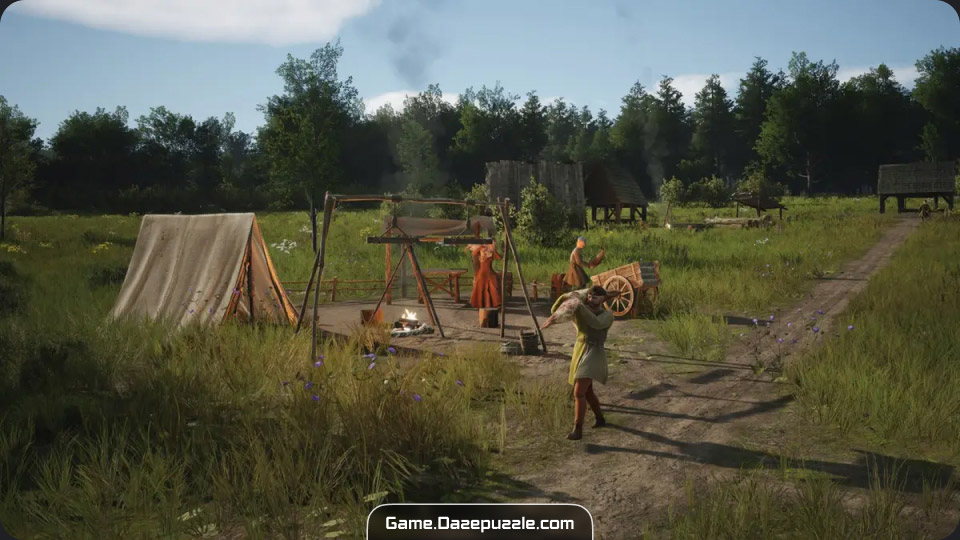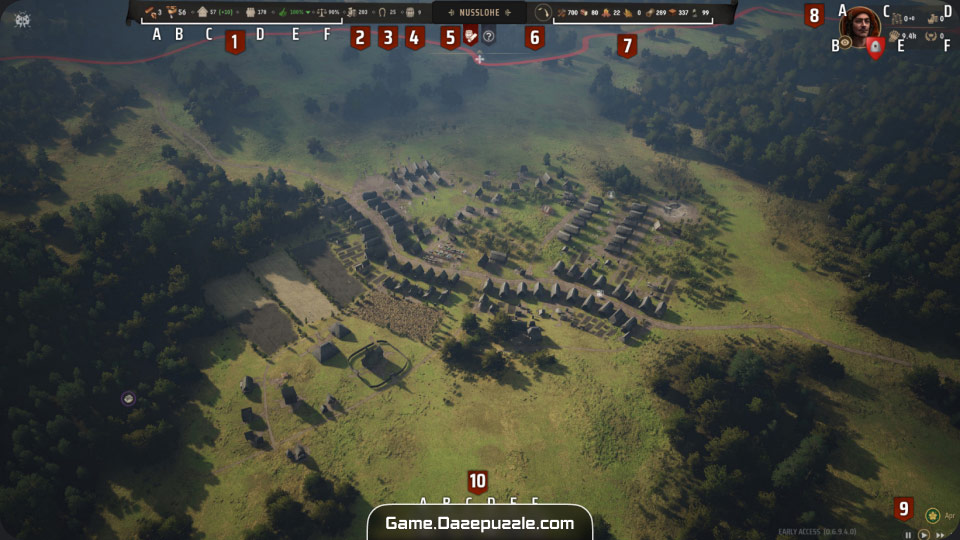So, you wanna be a Lord, huh? Manor Lords lets you build your own medieval town, and it’s awesome! But let’s be real, it can be a bit tricky when you’re just starting out. Don’t worry, though, because this Manor Lords Beginner’s Guide will help you get your lordship off to a great start.
Table of Contents
What is Manor Lords Anyway?
Manor Lords is a game where you get to build a town in medieval times. You start with just a few villagers and some resources, and your goal is to make your town bigger and better. It’s like a city-building game, but you also have to think about strategy and how to manage everything.
If you’re new to this kind of game, don’t sweat it! Manor Lords lets you take your time, especially if you play on the regular speed. A good way to start is by playing the “Rise to Prosperity” scenario. This lets you learn how to build your town without having to stress too much about fighting.
The best part? You get to see your tiny village grow into a big, bustling town. Pretty cool, right?
How to Start Your Town in Manor Lords
Okay, so you’ve just started the game. What now? When you begin the game, it’s advisable to immediately pause. Seriously, hit that pause button right away! This gives you time to look around and plan without anything happening in real-time. The initial survey should prioritize identifying key early-game food sources, such as berries and wild animals. These will be essential for sustaining your initial population. Additionally, noting the locations of stone, iron, and clay deposits is beneficial for future planning, as these resources will be crucial for later development and more advanced constructions.

Essential Buildings: The Heart of Your Village
Now, let’s get building! These are the most important buildings to start with:
- Logging Camp: This is super important. It gets you Timber, and you need Timber for basically everything else.
- Storehouse: This is where you keep all your stuff – building materials, resources, everything. It also keeps them from getting ruined by the weather.
- Granary: This is just for food. You don’t want your food to go bad, right?
- Well: Your villagers need water to survive, so get a well built ASAP.
- Marketplace: This is where your villagers get their food and firewood. It’s also important if you want to upgrade your Burgage Plots later (we’ll get to those in a bit).
- (Optional) Woodcutter’s Lodge: You’ll need firewood to keep your villagers warm in the winter. Build this early, but maybe not right away. Put it near some trees, but not the same trees your Logging Camp is using.
Quick Tip: Don’t upgrade those starting “Homeless People’s Tents” just yet. Focus on getting your resources and storage buildings up first.
Table of Essential Buildings & Their Uses
| Building Name | Purpose | Why It’s Important |
|---|---|---|
| Logging Camp | Produces Timber | You need Timber for almost everything you build. |
| Storehouse | Stores resources | Keeps your resources safe and ready to use. |
| Granary | Stores food | Keeps your food from spoiling, so your villagers don’t starve. |
| Well | Provides water | Villagers need water to be happy and healthy. |
| Marketplace | Distributes food & firewood | Helps your villagers get what they need and is needed to upgrade Burgage Plots. |
| (Optional)Woodcutter’s Lodge | Produces Firewood | Keeps your villagers warm during the winter. |
Resource Management Strategies for Beginners
To make your town awesome, you’ve got to manage your resources well. Resource management forms the very core of a successful settlement in Manor Lords.
- Timber: We talked about this already. It’s super important, especially at the start.
- Food: Your villagers gotta eat! Berries and wild animals are your go-to food sources early on.
- Stone, Iron, and Clay: You won’t need these right away, but keep in mind where they are. You’ll need them later for more advanced stuff.
A few tips on resources:
- Logging Camp Placement: Be careful where you put your Logging Camp. Don’t put it too close to berry bushes or wild animals, or you might accidentally clear them out.
- Firewood is NOT from the Logging Camp: Remember, Firewood comes from the Woodcutter’s Lodge, not the Logging Camp. So, you need a separate area for that.
- Assign Families to Jobs: You need to tell your villagers what to do! Assign families to work at the Logging Camp, Storehouse, and Granary.
- Get More Food Sources: As your town grows, you’ll need more food. Build a Hunting Camp or Forager Hut to get more meat or berries. Which one you build depends on what’s available near you.
- Diversify Your Economy: Later in the game, find those gold crown icons on the map. These show rich resource deposits. You’ll want to build special buildings to get those resources and make better stuff.
- Think About Supply Chains: Resources are connected. For example, to make Planks, you need Timber and a Sawmill, and you need oxen to carry the logs. So, plan ahead!
Early Game Resource Management Tips
| Resource Name | How to Obtain (Early Game) | Primary Use (Early Game) |
|---|---|---|
| Timber | Families at the Logging Camp | Building stuff. |
| Berries | Families at the Forager Hut | Food. |
| Wild Animals | Families at the Hunting Camp | Food. |
| Firewood | Families at the Woodcutter’s Lodge | Heating for villagers during winter. |
Optimal Village Layout for Manor Lords Beginners
The way you build your village is super important for efficient functioning. It’s highly recommended to build roads first. Connect all your important buildings so your villagers and ox can move around easily, and make sure to leave space for more buildings later. Central locations are key for certain buildings. Put your Storehouse and Granary in the middle of your village to make it easy to get resources to the Marketplace.
The Marketplace should also be in a central spot so villagers can easily get food and firewood. Remember to leave plenty of room around the Marketplace for houses and market stalls, aiming for at least 15 stalls. Burgage Plots, which are houses, should be built, starting with at least five or six. Don’t forget the importance of wells; you need them for water. Look for blue areas on the map – that’s where you can build them. Finally, consider building a Wooden Church in the center of town later on, as it contributes to the happiness of your villagers.

Best Food Sources for Beginners in Manor Lords
Keeping your villagers fed is really important for the survival and growth of your settlement. When considering early food sources, berries and wild animals are your best bet at the start. You can build a Forager Hut for berries or a Hunting Camp for animals; Hunting Camps might be slightly better at the very beginning. Placement of food production buildings is important. Put them near the resources, but not right on top of them.
Hunting Camps need to be close enough so the hunters don’t have to walk too far. Once you have enough Timber, upgrade your housing by building some Burgage Plots. Upgrading them with Chicken Coops provides eggs, while Vegetable Gardens give you even more food. Goat Sheds provide food and leather. It’s crucial to keep the food flowing. Make sure there’s a good path from your food buildings to the Marketplace, ensuring your villagers have access to the food. Lastly, it’s advisable not to rush farming early on; it’s tricky at the start. Focus on hunting, foraging, and Burgage Plot upgrades for now, but do check your map for fertile areas for future farms.
You might also like this: Split Fiction Review: Enchanting Co-op Chaos
How to Keep Villagers Happy in Manor Lords
Happy villagers are productive villagers. To keep those smiles up, ensure you build enough housing. Aim for at least five or six Burgage Plots to start, and always have at least one empty house for new families. The Marketplace is key, so put it near the houses so people can easily get food and firewood. Upgrading your housing by adding things like Chicken Coops, Vegetable Gardens, and Goat Sheds makes your villagers happier and provides more resources.
It’s important to keep approval high; aim for an approval rating above 50% to get more people moving into your town, and over 75% is even better. Remember that new families won’t come if there are no empty houses. Building a church, specifically a Wooden Church, also makes your villagers happier and improves your approval rating. Providing variety is also important; having different kinds of food at the Marketplace contributes to their happiness. Finally, when building houses (Burgage Plots), make sure they’re big enough for housing upgrades like Chicken Coops. The game will show you a white line to indicate sufficient size.
Infrastructure: Making Your Town Work
Good infrastructure means a smooth-running town.
- Roads, Roads, Roads: We can’t say this enough: build roads first. Connect all your important buildings, especially the Logging Camp to your main village area. Also, build roads towards your early food sources.
- Oxen are Your Friends: Oxen carry Timber, which you need for building. Get a second ox early to speed things up! You can even assign a villager to be a full-time ox-wrangler. Later, you’ll use other animals like mules and horses for trade.
- Economy Basics: There are two types of wealth: Treasury (your personal money) and Regional Wealth (your town’s money). You need Regional Wealth to get Treasury.
- Trading Post: Build this to trade with other towns. Set up Trade Rules for each item you want to buy or sell. Leather is a good early export. If you export resources like Planks, set a surplus so you don’t sell them all.
- Winter is Coming: Prepare for winter by having lots of Firewood and Food. The Marketplace is where villagers get these. Have more than one food source in case one runs out.
- Beyond the Basics: Later on, focus on farming, advanced resource production, and upgrading your Burgage Plots. Claiming nearby regions will get you more resources. Build a Manor to collect taxes and manage your soldiers. You’ll need to defend your land!
- Tips and Tricks:
- Start with city-building focused settings.
- Check the terrain for resources before building.
- Prioritize one construction project at a time.
- Assign families to buildings.
- Plan your Burgage Plots for future upgrades.
- Use Chicken Coops and Vegetable Gardens for food.
- Get a second ox early.
- Be patient with building.
- Reassign farmers in summer.
- Assign families to the Granary and Storehouse.
- Buy Ale from traders if needed.
- Reassign villagers to different jobs as needed.
- Keep taxes low early on.
Advanced Tips & Tricks for Becoming a Great Lord
To build a great town in Manor Lords, you need to plan carefully, manage your resources well, and take care of your villagers. Start by getting Timber, food, and important buildings like the Storehouse and Marketplace. Keep your villagers happy with houses and food. Remember that oxen are key for moving resources, and you need to get ready for winter. It might be hard at first, but if you keep at it, you’ll build an awesome medieval town!
Manor Lords lets you plan and manage your town in detail, and it’s a really fun experience for anyone who wants to rule their own medieval land.






